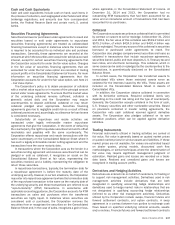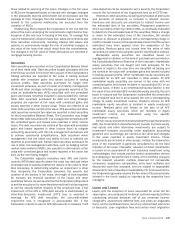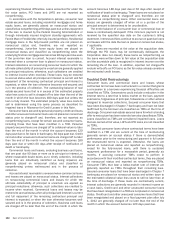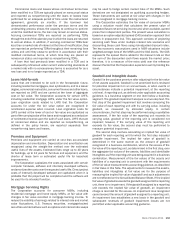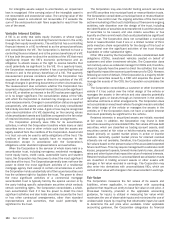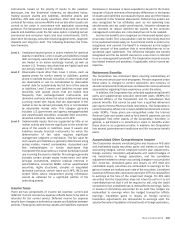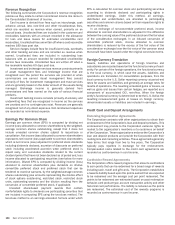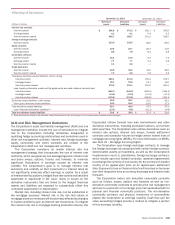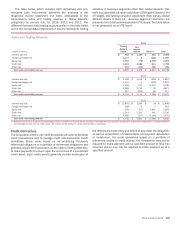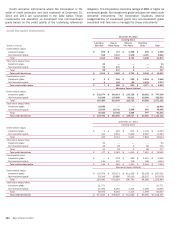Bank of America 2014 Annual Report Download - page 157
Download and view the complete annual report
Please find page 157 of the 2014 Bank of America annual report below. You can navigate through the pages in the report by either clicking on the pages listed below, or by using the keyword search tool below to find specific information within the annual report.Bank of America 2014 155
instruments, based on the priority of inputs to the valuation
technique, into this three-level hierarchy, as described below.
Trading account assets and liabilities, derivative assets and
liabilities, AFS debt and equity securities, other debt securities
carried at fair value, consumer MSRs and certain other assets are
carried at fair value in accordance with applicable accounting
guidance. The Corporation has also elected to account for certain
assets and liabilities under the fair value option, including certain
commercial and consumer loans and loan commitments, LHFS,
short-term borrowings, securities financing agreements, long-term
deposits and long-term debt. The following describes the three-
level hierarchy.
Level 1 Unadjusted quoted prices in active markets for identical
assets or liabilities. Level 1 assets and liabilities include
debt and equity securities and derivative contracts that
are traded in an active exchange market, as well as
certain U.S. Treasury securities that are highly liquid and
are actively traded in OTC markets.
Level 2 Observable inputs other than Level 1 prices, such as
quoted prices for similar assets or liabilities, quoted
prices in markets that are not active, or other inputs that
are observable or can be corroborated by observable
market data for substantially the full term of the assets
or liabilities. Level 2 assets and liabilities include debt
securities with quoted prices that are traded less
frequently than exchange-traded instruments and
derivative contracts where fair value is determined using
a pricing model with inputs that are observable in the
market or can be derived principally from or corroborated
by observable market data. This category generally
includes U.S. government and agency mortgage-backed
and asset-backed securities, corporate debt securities,
derivative contracts, certain loans and LHFS.
Level 3 Unobservable inputs that are supported by little or no
market activity and that are significant to the overall fair
value of the assets or liabilities. Level 3 assets and
liabilities include financial instruments for which the
determination of fair value requires significant
management judgment or estimation. The fair value for
such assets and liabilities is generally determined using
pricing models, market comparables, discounted cash
flow methodologies or similar techniques that
incorporate the assumptions a market participant would
use in pricing the asset or liability. This category generally
includes certain private equity investments and other
principal investments, retained residual interests in
securitizations, consumer MSRs, certain asset-backed
securities, highly structured, complex or long-dated
derivative contracts, certain loans and LHFS, IRLCs and
certain CDOs where independent pricing information
cannot be obtained for a significant portion of the
underlying assets.
Income Taxes
There are two components of income tax expense: current and
deferred. Current income tax expense reflects taxes to be paid or
refunded for the current period. Deferred income tax expense
results from changes in deferred tax assets and liabilities between
periods. These gross deferred tax assets and liabilities represent
decreases or increases in taxes expected to be paid in the future
because of future reversals of temporary differences in the bases
of assets and liabilities as measured by tax laws and their bases
as reported in the financial statements. Deferred tax assets are
also recognized for tax attributes such as net operating loss
carryforwards and tax credit carryforwards. Valuation allowances
are recorded to reduce deferred tax assets to the amounts
management concludes are more-likely-than-not to be realized.
Income tax benefits are recognized and measured based upon
a two-step model: first, a tax position must be more-likely-than-not
to be sustained based solely on its technical merits in order to be
recognized, and second, the benefit is measured as the largest
dollar amount of that position that is more-likely-than-not to be
sustained upon settlement. The difference between the benefit
recognized and the tax benefit claimed on a tax return is referred
to as an unrecognized tax benefit. The Corporation records income
tax-related interest and penalties, if applicable, within income tax
expense.
Retirement Benefits
The Corporation has retirement plans covering substantially all
full-time and certain part-time employees. Pension expense under
these plans is charged to current operations and consists of
several components of net pension cost based on various actuarial
assumptions regarding future experience under the plans.
In addition, the Corporation has unfunded supplemental benefit
plans and supplemental executive retirement plans (SERPs) for
selected officers of the Corporation and its subsidiaries that
provide benefits that cannot be paid from a qualified retirement
plan due to Internal Revenue Code restrictions. The Corporation’s
current executive officers do not earn additional retirement income
under SERPs. These plans are nonqualified under the Internal
Revenue Code and assets used to fund benefit payments are not
segregated from other assets of the Corporation; therefore, in
general, a participant’s or beneficiary’s claim to benefits under
these plans is as a general creditor. In addition, the Corporation
has several postretirement healthcare and life insurance benefit
plans.
Accumulated Other Comprehensive Income
The Corporation records unrealized gains and losses on AFS debt
and marketable equity securities, gains and losses on cash flow
accounting hedges, certain employee benefit plan adjustments,
foreign currency translation adjustments and related hedges of
net investments in foreign operations, and the cumulative
adjustment related to certain accounting changes in accumulated
OCI, net-of-tax. Unrealized gains and losses on AFS debt and
marketable equity securities are reclassified to earnings as the
gains or losses are realized upon sale of the securities. Unrealized
losses on AFS securities deemed to represent OTTI are reclassified
to earnings at the time of the impairment charge. For AFS debt
securities that the Corporation does not intend to sell or it is not
more-likely-than-not that it will be required to sell, only the credit
component of an unrealized loss is reclassified to earnings. Gains
or losses on derivatives accounted for as cash flow hedges are
reclassified to earnings when the hedged transaction affects
earnings. Translation gains or losses on foreign currency
translation adjustments are reclassified to earnings upon the
substantial sale or liquidation of investments in foreign operations.




